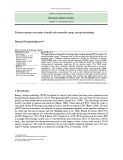
Renewable energy technologies
-
Solar energy, light and heat radiation from the Sun, has been exploited by humans since ancient times using a variety of technology development than ever before. Solar radiation along with secondary resources of energy like wind and solar energy, water power and biomass, make the most of renewable energy available on earth. Only a tiny fraction of the available solar energy is used.
 202p
202p  minhhai20789
minhhai20789
 26-04-2011
26-04-2011
 249
249
 117
117
 Download
Download
-
This paper proposes a framework for selecting energy storage technology (EST) for small-scale renewable energy systems. The present study was able to achieve this using the results that were generated from a Preference Ranking Organisation Method for Enrichment Evaluation (PROMETHEE) and a fuzzy quality function deployment (FQFD) model.
 10p
10p  tohitohi
tohitohi
 22-05-2020
22-05-2020
 22
22
 1
1
 Download
Download
-
Landfill gas from a source of green energy, clean, renewable and can be used to create electricity, or used in the energy industry. This paper reviews the potential energy recovery landfill gas from municipal solid waste, to reducing methane emissions in particular, and reduced greenhouse gas emissions in general. In addition, this paper provides an assessment using the model of methane generated from landfill municipal solid waste and generate energy potential of gas recovered. In particular, this paper uses a life cycle assessment methods ......
 10p
10p  thulanh2
thulanh2
 07-09-2011
07-09-2011
 104
104
 18
18
 Download
Download
-
The global annual potential bioethanol production from the major crops, corn, barley, oat, rice, wheat, sorghum, and sugar cane, is estimated. To avoid con/icts between human food use and industrial use of crops, only the wasted crop, which is de0ned as crop lost in distribution, is considered as feedstock. Lignocellulosic biomass such as crop residues and sugar cane bagasse are included in feedstock for producing bioethanol as well. There are about 73:9 Tg ofdry wasted crops in the world that could potentially produce 49:1 GL year−1 ofbioethanol.
 15p
15p  nguyenngocsonctu
nguyenngocsonctu
 30-11-2010
30-11-2010
 134
134
 22
22
 Download
Download
-
Problem statement: Dilute sulphuric acid and enzymatic hydrolysis methods were used for sugar extraction. Xylose and glucose sugars were obtained from corn cobs. Approach: Acid hydrolysis of corn cobs gave higher amount of sugars than enzymatic hydrolysis. Results: The results showed that optimal temperature and time for sugar fermentation were approximately 25°C and 50 h by two yeast strains (S. cerevisiae and P. Stipitis) respectively.
 6p
6p  nguyenngocsonctu
nguyenngocsonctu
 30-11-2010
30-11-2010
 142
142
 18
18
 Download
Download















